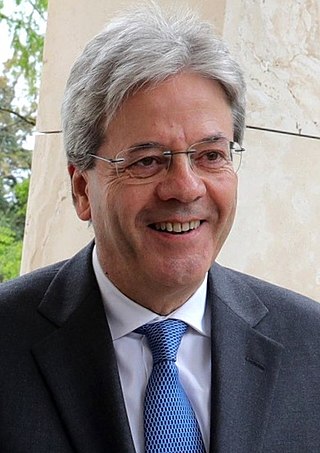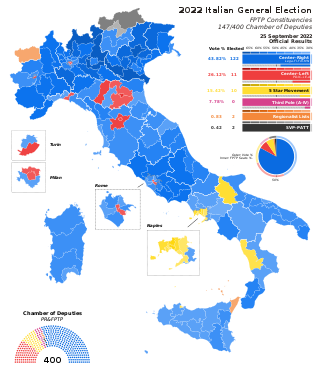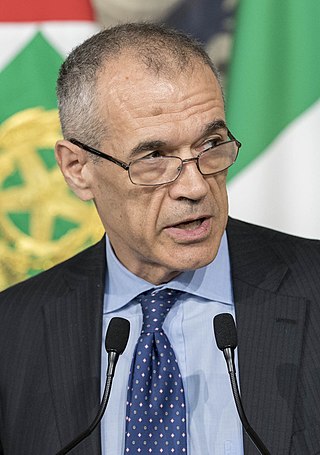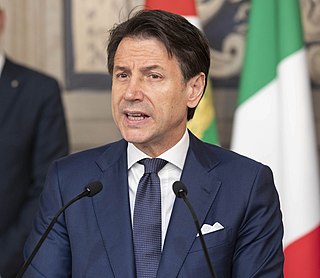
Sergio Mattarella is an Italian politician, jurist, academic, and lawyer who is currently serving as the 12th President of Italy since 2015. He is the longest-serving president in the history of the Italian Republic. Since Giorgio Napolitano's death in 2023, Mattarella has been the only living Italian president.

The 2018 Italian general election was held on 4 March 2018 after the Italian Parliament was dissolved by President Sergio Mattarella on 28 December 2017. Voters were electing the 630 members of the Chamber of Deputies and the 315 elective members of the Senate of the Republic for the 18th legislature of the Italian Republic since 1948. The election took place concurrently with the Lombard and Lazio regional elections. No party or coalition gained an absolute majority in the parliament, even though the centre-right coalition won a plurality of seats as a coalition, and the Five Star Movement (M5S) won a plurality of seats as an individual party.

Luigi Di Maio is an Italian politician who has been serving as EU Special Representative for the Gulf region since 1 June 2023. Di Maio also served as Minister of Foreign Affairs from 2019 to 2022, as Deputy Prime Minister of Italy and Minister of Economic Development, Labour and Social Policies from 2018 to 2019, and as Vice President of the Chamber of Deputies in the 17th Italian legislature.

Lorenzo Guerini is an Italian politician and member of the Democratic Party (PD). Guerini has been serving as the Italian Minister of Defence in the cabinets of successive prime ministers Giuseppe Conte and Mario Draghi from 2019 to 2022. In March 2014, he was chosen by party leader Matteo Renzi to be deputy secretary of the PD along with Debora Serracchiani, a position that he held until May 2017. From 2005 to 2012, he served as mayor of Lodi, Lombardy, his hometown.

Maurizio Martina is an Italian politician and former member of the Chamber of Deputies, who served as secretary of the Democratic Party (PD) from March to November 2018, being appointed after the 2018 Italian general election. He served as Minister of Agricultural, Food and Forestry Policies from 22 February 2014 to 13 March 2018, in the governments of Matteo Renzi and Paolo Gentiloni. On 7 May 2017, he was elected Deputy Secretary of the Democratic Party. Martina resigned as Agriculture Minister and took over as acting secretary of the PD after Matteo Renzi resigned following a poor election showing in 2018.

The Gentiloni government was the 64th government of the Italian Republic, in office from 12 December 2016 to 1 June 2018. The government was headed by Paolo Gentiloni, former Minister of Foreign Affairs of the Renzi government.

The 2022 Italian general election was a snap election held in Italy on 25 September 2022. After the fall of the Draghi government, which led to a parliamentary impasse, President Sergio Mattarella dissolved Parliament on 21 July, and called for new elections. Regional elections in Sicily were held on the same day. The results of the general election showed the centre-right coalition led by Giorgia Meloni's Brothers of Italy, a radical-right political party with neo-fascist roots, winning an absolute majority of seats in the Italian Parliament. Meloni was appointed Prime Minister of Italy on 22 October, becoming the first woman to hold the office.

In the 2018 Italian general election, no political group or party won an outright majority, resulting in a hung parliament. On 4 March, the centre-right coalition, in which Matteo Salvini's League emerged as the main political force, won a plurality of seats in the Chamber of Deputies and in the Senate, while the anti-establishment Five Star Movement (M5S) led by Luigi Di Maio became the party with the largest number of votes. The centre-left coalition, led by Matteo Renzi and the then-governing Democratic Party (PD), came third. Protracted negotiations were required before a government formation could be ultimated.

Giuseppe Conte is an Italian jurist, academic, and politician who served as prime minister of Italy from June 2018 to February 2021. He has been the president of the Five Star Movement (M5S) since August 2021.

The first Conte government was the 65th government of the Italian Republic. It was led by Giuseppe Conte, an independent, and it was in office from 1 June 2018 to 5 September 2019.

Carlo Cottarelli is an Italian economist and former director of the International Monetary Fund.

Teresa Bellanova is an Italian politician and trade unionist, who served as Minister of Agriculture from September 2019 to January 2021 in the government of Giuseppe Conte. In 2018, she was elected in the Italian Senate for the Democratic Party (PD), but in 2019 she joined Italia Viva (IV), the new movement of Matteo Renzi. Bellanova was also a member of the Italian Chamber of Deputies from 2006 to 2018.

The 2019 Italian government crisis was a political event in Italy that occurred between August and September 2019. It includes the events that follow the announcement of the Minister of the Interior and leader of the League, Matteo Salvini, that he would revoke League's support of the cabinet and ask the President of the Republic to call a snap election. This provoked the resignation of Prime Minister Giuseppe Conte, and resulted in the formation of a new cabinet led by Conte himself.
Action is a liberal political party in Italy. Its leader is Carlo Calenda, a member of the European Parliament within the group of Renew Europe and former minister of Economic Development.

Italia Viva is a liberal political party in Italy founded in September 2019. The party is led by Matteo Renzi, a former Prime Minister of Italy and former secretary of the Democratic Party (PD). As of 2021, Italia Viva is a member of the European Democratic Party.

Vincenzo "Enzo" Amendola is an Italian politician of the Democratic Party (PD). On 5 September 2019, Amendola was appointed Minister of European Affairs in the Conte II Cabinet.

The 2021 Italian government crisis was a political event in Italy that began in January 2021 and ended the following month. It includes the events that follow the announcement of Matteo Renzi, leader of Italia Viva (IV) and former Prime Minister, that he would revoke IV's support to the Government of Giuseppe Conte.

Europeanists is a political party in Italy. Amid a government crisis triggered after Matteo Renzi announced that he would revoke Italia Viva's support to the government of Giuseppe Conte, Europeanists formed on 27 January 2021 as a component of a joint parliamentary group in the Italian Senate, with the aim to support Conte's cabinet.

The Draghi government was the 67th government of the Italian Republic, led by former President of the European Central Bank, Mario Draghi. It was in office between 13 February 2021 and 22 October 2022.

The 2022 Italian government crisis was a political event in Italy that began on 14 July. It includes the events that followed the announcement of Giuseppe Conte, leader of the Five Star Movement (M5S) and former Prime Minister of Italy, that the M5S would withdraw its support to the national unity government of Mario Draghi over a bill regarding an economic stimulus to combat the ongoing energy and economic crisis. The government fell a week later when the M5S, Lega, and Forza Italia did not take part in a vote of confidence in the Government.

















































